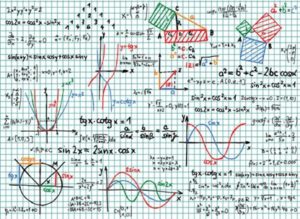Maths Methods Separator Questions
How to ace Difficult Questions in Methods
Table of Contents
Maths Methods Separator Questions
Separator questions – sound scary, don’t they? If you haven’t heard of the term before (which makes sense since we invented it) just go read the VCAA Examiner’s Report and look for the questions that only 1-5% of Methods students across the entire state get correct. It’s no wonder why we named them separators – they’re designed, precisely, to separate the 45+ study scores and perhaps the lower 40s.
If you’re one of those students who wants to get the very best study score possible, being able to complete the separator questions (correctly!) is absolutely crucial. To highlight their importance – in our paper (2020 VCAA), there were around 10 marks in Exam 1 and 20 marks in Exam 2 which less than 10% of the state scored full marks on. That’s quite literally a quarter of the entire exam!
In this guide, I’ve outlined the step by step approach I use to tackle Methods separator questions, so you can ace them too.
1. DON'T panic
The first and most important tip is to not panic. These questions are actually often easier than they outwardly seem. As soon as you start sweating and lose focus, it’s over. One of the things you should keep in mind is that although separators are crucial for achieving the very top scores, they’re ultimately a small percentage of the exam. There are many marks on the paper that you can do with much less time and effort, and if you can make sure to bank those marks, then separators are an opportunity to put yourself ahead, not a challenge to put you down. And remember, if you find a question difficult, chances are, 95% of the state are thinking the exact same thing. Don’t panic, and don’t let those few marks destroy your confidence and stop you from getting the rest.
2. Learn to skip
As I talked about in the previous step, there are many easier and quicker marks up for grabs in the exam. There is no point solving all the most challenging questions only to end up running out of time for the giveaway marks. If you find yourself spending more than a minute on a question with no progress, it is probably in your best interest to skip it for now and come back to it later. Once you’ve run through the entire paper, you can then work on the separators with complete peace of mind! And even if you run out of time at the end, it is a much better decision to invest your time into getting the simple questions right.
3. Get inspiration from previous parts
Assuming that you have finished everything else, you can now attempt the separator questions with a much calmer state of mind. The first thing to keep in mind is that the VCAA examiners aren’t complete sadists, believe it or not DISCLAIMER: most of the times
As the separators are usually the last part of an Extended Response question, or the last part of a Short Answer question stem, it is highly unlikely that the examiners will just throw random and totally irrelevant questions at you.
The questions are usually designed for you to work towards the end progressively, almost like a video game; in order to defeat the final boss, you have to use whatever you find at your disposal in the levels beforehand! This means that the key to solving a separator might just be to use values, expressions, graphs etc. from the previous sub questions. In other cases, the method to solve the question is simply an extension of the method you already used!
4. Just try everything, and don't give up!
Whilst most separator questions are built from the results of the previous sub questions, there are ultimately still some “curveballs” which are completely random. If you find yourself still stuck on the question after using all the traditional approaches familiar to you, it might just be time to forsake convention and carve your own path!
Assuming you have plenty of time and have checked over all the other questions, just start trying anything and everything you can. As most of these challenging questions usually involve a parameter (e.g. k, c, α), just try subbing in educated guesses, and see what happens! If that doesn’t work, try sketching a graph and play around with the values using the slider function, and observe any changes to the graph’s key features (stationary points, asymptotes, intercepts, etc)
You can also try a “brute force” approach. Which is where you find as many relevant equations involving the variables as you can, and then shove it all into the CAS simultaneous equation solver, and pray for the best! This is usually more applicable to SACs, but you’ll be surprised how often this approach works.
5. Find patterns and develop your own method
What is theory without applications? Ultimately, the best way to improve your ability is to do these separator questions through lots and lots of practice.
First, believe it or not, separator questions have patterns. To save you from the pain of discovering it yourself, we’ve sorted them into 6 distinct categories, with plenty of examples for each question type, all in this 20 page booklet. It consists of more than 60 marks of the most challenging questions you will ever come across, with video dissection and solutions for each type.

However, another way to get better at these is to make your own separator questions bank. Whenever you come across a challenging question, just screenshot it and compile it in a Word doc somewhere. You can print it out and attempt it again the days before the exam as revision. You can even put it in your bound reference to take into Exam 2! That way, when encountering a separator, you can simply refer to your solutions when encountering a similar question.








